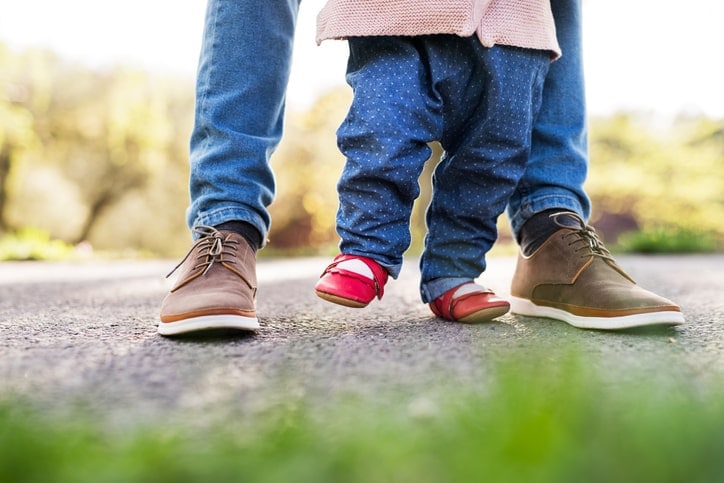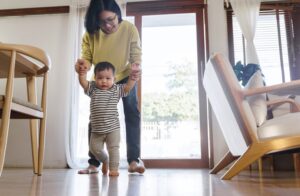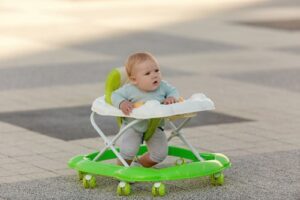Most babies start walking independently within 2-3 months of learning to stand up by themselves. But there are other signs, and there is no single developmental timeline that all babies follow. In fact, the onset of walking is extremely variable, with some babies walking before 9 months, and others waiting until they are 18 months or older.

When do babies start walking? In the United States today, the average age of independent walking is approximately 12 months. Researchers report similar timing for babies in a number of other countries, including Argentina, Ghana, India, Norway, Oman, South Africa, and Turkey. On average, babies in these countries take their first, unassisted steps at around 12-13 months (WHO 2006a; Ertem et al 2018).
But there are cultures where most babies begin walking months earlier – or many months later. And even within a single society, the range of individual variation can be huge. For example, in a study tracking the development of 220 children in Switzerland, a few babies began walking independently at 8.5 months. And some babies didn’t walk until they were nearly 20 months old. Yet all of those children experienced healthy, normal outcomes. The timing of independent walking was unrelated the children’s later motor development and cognitive ability (Jenni et al 2013).
Of course, that isn’t always the case. Sometimes delays in the onset of walking are caused by medical conditions or developmental disorders. But most late walkers don’t have these problems.
So what’s normal? What should we expect? How can we tell if a baby is ready to walk, and what makes some babies begin walking earlier than others? Here’s an overview, beginning with the motor skills that babies must master before they start walking on their own.
What are signs that a baby will start walking soon?
Before they can walk, babies need to develop the strength and coordination to maintain an upright posture on their own. They also need to be able to bear most of their weight – at least momentarily – on one foot. So babies are moving closer to independent walking when they achieve these motor milestones:
Milestone: Pulling oneself up into a standing position (by gripping furniture, or holding onto someone)

Typically, babies develop this ability about 4 months before they take their first, independent steps (Ertem et al 2018). During early attempts, a baby will be able to remain standing for only a few seconds, and you will notice that the baby’s legs are stiff and straight (as they are in this photo). But as the baby gets stronger, he or she will be able to stand comfortably — with knees slightly flexed — while holding on.
Milestone: Walking with support

At this stage, babies have the strength to shift their weight from one leg to the other. If you hold a baby by the hands, he can walk forward. If a baby grabs onto a piece of furniture (like a couch or sofa), she can “cruise,” or move along sideways. When will a baby with these abilities begin walking independently?
Studies suggest that independent walking tends to emerge about 3 months later (WHO 2006a; Ertem et al 2018), but there’s no strict sequence that all babies follow. Some babies begin walking with support relatively early — even before they have learned to crawl. For these babies, the next stage might be independent walking. But babies might also shift their focus to crawling (WHO 2006b).
Milestone: Standing alone (at least momentarily!)

How long after learning to stand unassisted do babies begin to walk? International studies suggest that most babies start walking within 2-3 months of learning to stand (Ertem et al 2018). But it isn’t the absolute passage of time that matters so much. It’s the sheer amount of practice and hard work.
When babies are learning to walk independently, they fall down. A lot. Some babies don’t seem to mind much. They enthusiastically throw themselves into the project, and learn to walk rather quickly — sometimes within a few days of learning to stand.
What about crawling? Do babies have to crawl before they can walk?
Absolutely not. In fact, some babies never crawl. Read more about it in my article “When do babies crawl, and how does crawling develop: An illustrated guide.”
When can babies walk with support?
International research suggests that approximately 50% of all babies have begun walking with support by the age of 9.5 months (WHO 2006a; Ertem et al 2018). But local norms differ.
In cultures where parents actively teach their babies to walk, infants may begin assisted walking by 7-8 months (e.g., Super 1976). By contrast, in places where parents take a more hands-off approach, the average onset of walking with support is later – closer to 10.5 months (WHO 2006a). And in societies where babies remain physically restrained throughout the day – in carriers, slings, cradles, and other devices – babies don’t begin walking until much later.
When do babies make the transition to independent walking?
As noted in the introduction, there is a wide range of variation here. Some babies begin before they are 9 months old. Others take 18 months or more. Why is there so much variation, and what sort of factors predict whether a child will walk earlier or later?
Human bipedalism is a difficult trick to learn. Babies face many obstacles, including their own bodies. For instance, a baby with skinny legs – and a higher muscle-to-fat- ratio – will have an easier time fighting gravity, and may begin walking sooner than a plumper, less muscular infant (Adolf 2008). The timing of walking also depends on opportunities for movement and practice.
In general, babies who get more exercise – time outside a sling, crib, or cradle – tend to achieve motor milestones earlier in life. More specifically, babies learn to walk earlier if they get lots of practice with “assisted walking” — taking steps forward while someone holds their hands.
Motivation is probably important, too. For example, researchers have found that babies are more likely to start learning to walk if they show an interest in accessing distant objects, such as toys (Karasik et al 2011).
And something as mundane as clothing can make a difference. Experimental research confirms that it’s harder for babies to walk when they are wearing diapers. The bulk gets in the way – forcing them to waddle with their legs farther apart – and babies are more likely to lose their balance and fall (Cole et al 2012).
Together, these factors can help explain why babies vary as individuals. They can also shed light on some of the dramatic differences we observe between cultures.
How do parenting practices affect the development of walking?
Consider the Kipsigis of Kenya, people who raise crops and herd cattle. In this culture, parents actively encourage infants to develop motor skills essential for walking. It begins with something called the stepping reflex: Hold a newborn baby upright – allowing his or her feet to touch the ground – and the baby will appear to take alternating steps. As if the baby is ready to walk!
Of course, the baby isn’t really ready to walk, not yet. Young babies lack the muscle development, coordination, and body proportions to walk successfully when they are very young. And if we simply ignore this stepping response, the behavior will eventually fade. In Western countries, for example, the stepping response usually disappears by the time babies are 8 weeks old.
But the Kipsigis don’t ignore the stepping reflex. Instead, they turn it into a game. Supporting babies by the armpits, mothers bounce their babies on their laps, stimulating the stepping reflex.
The games start when babies are about one month old, and babies experience daily practice. By the time they are 7-8 months old, infants are strong enough to begin walking (with support) on the ground. There is never a point when babies lose the stepping response. Instead, there is a continuous, gradual development of ever-stronger stepping (Super 1976).
When researchers tested a similar approach on babies living in the United States, they noticed the same thing: Babies didn’t lose the stepping response over time, not when they were encouraged to practice it (Zelazo 1983). And in both groups — Kipsigis and Americans — researchers observed a relationship between practice and the timing of walking. Babies who practiced step-walking tend to walk independently at an earlier age (Super 1976; Zelazo 1983).
So parents can stimulate the development of walking through exercise and play. In fact, even “tummy time” has been linked with the development of walking. The more time young babies spend on their tummies, the earlier they tend to reach the motor milestones of assisted walking and independent walking (Carson et al 2022).
Moreover, the reverse is true as well: When babies experience higher levels of movement restriction – by being held, swaddled, strapped into a chair, or otherwise immobilized during the day – they begin walking later (Adolph and Robinson 2013; Carson et al 2022).
For an extreme case, consider the Ache of Paraguay, people who practiced hunting and gathering until the late 20th century. When they were living in the old, traditional way, the Ache carried their babies almost constantly. They regarded their environment – the Amazonian rain forest – to be too dangerous to set infants down. So Ache babies didn’t get opportunities to practice walking, and, as a result, children didn’t learn to walk until they were approximately 24 months old (Kaplan and Dove 1987).
I call this an extreme case, but “extreme” is a relative term: It depends on what populations you use for comparison. The Ache aren’t the only hunter-gatherers who avoided setting their babies on the ground. And people in other societies follow customs that restrict infant movement. For instance, throughout Central Asia, babies spend long hours each day restrained in a traditional cradle called a “gahvora” (Karasik et al 2018). In different times and places, it might have been pretty common for babies to miss out on the sort of experiences that lead to early walking. And that should make us re-evaluate our ideas about what constitutes “normal” development.
It doesn’t make sense to talk about “normal” timing in a vacuum, as if local differences in the environment don’t matter.
Can “walking toys” help babies learn to walk?
Another name for “walking toys” is “locomotor toys” — toys that are designed to be pushed, pulled, or rolled. What happens if you provide a baby with such toys — like a “popper” push toy, which pops plastic balls when you roll it along the ground? It isn’t clear that this will motivate a baby who isn’t yet walking to take his or her first steps. But push toys and pull toys might encourage early walkers to keep at it longer.
In a study of 40 walking babies (average age: 15 months), Justine Hoch and her colleagues assigned half of them to spend time in a room with a caregiver and several locomotor toys. The other half spent time with a caregiver in the same room, but without toys. The researchers recorded the infants’ movements, and found that babies in both groups walked around in equal amounts. But the babies provided with locomotory toys walked in longer bouts — taking more steps before coming to a halt. They were also more likely to explore every part of the playroom, and to stray farther from their caregivers (Hoch et al 2019).
What about baby walkers? Why do experts warn parents against using them?

A baby walker is a rigid frame, on wheels, with a seat suspended in the middle. When an infant is placed in the seat, his or her toes reach the ground, and the baby is able to move independently by pushing off in various directions.
It might sound like a shortcut for learning to walk, but it isn’t. On the contrary, when infants use baby walkers, they frequently adopt abnormal postures and gait patterns. For instance, they may lean backwards, walk on tiptoes, or fail to control the movement of their heads (Schecter et al 2019). They aren’t actually practicing the movements they need to master to learn to walk.
Moreover, the trend across studies is either neutral or negative. Some studies have found that baby walkers confer no motor skill advantages. Others have reported distinct disadvantages — that infants who use walkers tend to be slower to reach motor milestones, including crawling, standing alone, and walking independently (Badihian et al 2017; Schecter et al 2019; Bezgin et al 2021).
But the most important problem concerns safety. Baby walkers are linked with high rates of injury. Accidents are often caused by babies falling down the stairs while in a walker, and there are other hazards too. Infants have fallen out of their walkers. They’ve injured themselves by reaching for objects that are heavy, sharp, or burning-hot. And the injuries can be serious – concussions, lacerations, bone fractures. Some infants have died (Sims et al 2018).
Given these dangers – and the lack of developmental benefits – the American Academy of Pediatrics has recommended a ban on the manufacture and sale of baby walkers (American Academy of Pediatrics 2001), and baby walkers have been banned in Canada since 2004 (Skinner et al 2010).
When should a parent be concerned that a baby isn’t walking? At what point is a child considered to have developmental delay?
Organizations like the American Academy of Pediatrics (APP) recommend that you talk with your doctor if your baby can’t walk by the age of 18 months. And that’s good advice. Sometimes, delayed walking is a sign of a physical problem, so it’s good to investigate early, and take action. In a review of more than 400 “late walkers”, nearly one-third of the cases were attributable to some kind of underlying clinical or neurological condition (Chaplais and McFarlane 1984).
But keep in mind: Most babies who haven’t yet begun walking at 18 months do not suffer from developmental problems. Not if they are otherwise healthy.
More reading about baby developmental milestones
As we’ve seen, babies don’t learn to walk on a fixed time schedule. The timing can vary dramatically from one individual to the next. The same is true for many other motor skills. To learn more about it, see my article on baby motor milestones.
In addition, check out my guide to the development of crawling, as well as these articles about baby development:
- When do babies say their first words?
- Can babies sign before they speak?
- Do babies feel empathy?
- Can babies sense stress in others?
- Can babies tell when their parents are fighting?
- Moral sense: Babies prefer underdogs and do-gooders
- Stress in babies: How to keep babies calm, happy, and emotionally healthy
- How friendly eye contact can make infants tune in — and mirror your brain waves.
References: When do babies start walking?
Note to the scholarly: If you want to dive into the scientific literature about walking, be sure to check out the work of Karen Adolph and Lana Karasik.
Adolph heads a research team at New York University. Many of her lab’s publications can be downloaded for free from the NYU infant action lab. Karasik is currently at the City University, CUNY. You can find her publications is at the Karasik Lab of Culture & Development.
Adolph KE. 2008. Motor and physical development: Locomotion. In M. M. Haith & J. B. Benson, (Eds.), Encyclopedia of infant and early childhood development (pp. 359-373). San Diego, CA: Academic Press.
Adolph KE and Robinson SR. 2013. The road to walking: What learning to walk tells us about development. In P. Zelazo (Ed), Oxford handbook of developmental psychology (pp. 403-443). Oxford: Oxford University Press.
American Academy of Pediatrics. Committee on Injury and Poison Prevention. 2001. Injuries associated with infant walkers. Pediatrics. 108(3):790-2.
Badihian S, Adihian N, Yaghini O. 2017. The Effect of Baby Walker on Child Development: A Systematic Review. Iran J Child Neurol. 11(4):1-6.
Bezgin S, Uzun Akkaya K, Çelik Hİ, Duyan Çamurdan A, Elbasan B. 2021. Evaluation of the effects of using a baby walker on trunk control and motor development. Turk Arch Pediatr. 56(2):159-163.
Carson V, Zhang Z, Predy M, Pritchard L, and Hesketh KD. 2022. Longitudinal associations between infant movement behaviours and development. Int J Behav Nutr Phys Act. 19(1):10.
Chaplais JD and Macfarlane JA. 1984. A review of 404 ‘late walkers’. Arch
Dis Child. 59(6): 512–516.
Cole WG, Lingeman JM, Adolph KE. 2012. Go naked: diapers affect infant walking. Dev Sci. 15(6):783-90.
Hoch JE, O’Grady SM, Adolph KE. 2019. It’s the journey, not the destination: Locomotor exploration in infants. Dev Sci. 22(2):e12740.
Kaplan H and Dove H. 1987. Infant development among the Ache of eastern Paraguay. Developmental Psychology, 23(2): 190–198.
Karasik LB, Tamis-LeMonda CS, Ossmy O, and Adolph KE. 2018. The ties that bind: Cradling in Tajikistan. PLoS ONE, 13(10): e0204428–18.
Karasik LB, Tamis-LeMonda CS, and Adolph KE 2011. Transition from crawling to walking and infants’ actions with objects and people. Child Development, 82, 1199-1209.
Jenni OG, Chaouch A, Caflisch J, and Rousson V. 2013. Infant motor milestones: poor predictive value for outcome of healthy children. Acta Paediatrica 102 (4): e181
Schecter R, Das P, Milanaik R. 2019. Are Baby Walker Warnings Coming Too Late?: Recommendations and Rationale for Anticipatory Guidance at Earlier Well-Child Visits. Glob Pediatr Health. 6:2333794X19876849.
Sims A, Chounthirath T, Yang J, Hodges NL, Smith GA. 2018. Infant Walker-Related Injuries in the United States. Pediatrics. 142(4):e20174332
Skinner R, Ugnat AM, Grenier D. 2010. Baby products and injuries in Canada: Is it still an issue? Paediatr Child Health. 15(8):490.
Super CM. 1976. Environmental effects on motor development: the case of “African infant precocity”. Dev Med Child Neurol. 18(5):561-7.
WHO Multicentre Growth Reference Study Group. 2006a. Assessment of sex differences and heterogeneity in motor milestone attainment among populations in the WHO Multicentre Growth Reference Study. Acta Paediatr Suppl. 450:66-75.
Zelazo PR 1983. The development of walking: New findings and old solutions. Journal of Motor Behavior 15: 99-137.
Content of “When do babies start walking” last modified 8/2/2022. Portions of the text derive from an earlier version of this article, written by the same author.
Image credits for “When do babies start walking”:
image of toddler’s and parent’s legs by Halfpoint/ istock
image of baby standing independently with arms in the air by Prostock-studio / shutterstock
image of baby girl pulling herself up into a standing position by grasping a kitchen chair by Ekaterina Pokrovsky/shutterstock
image of infant seated in a green baby walker by Drovnin / shutterstock
image of mother helping baby walk by eggeeggjiew / istock